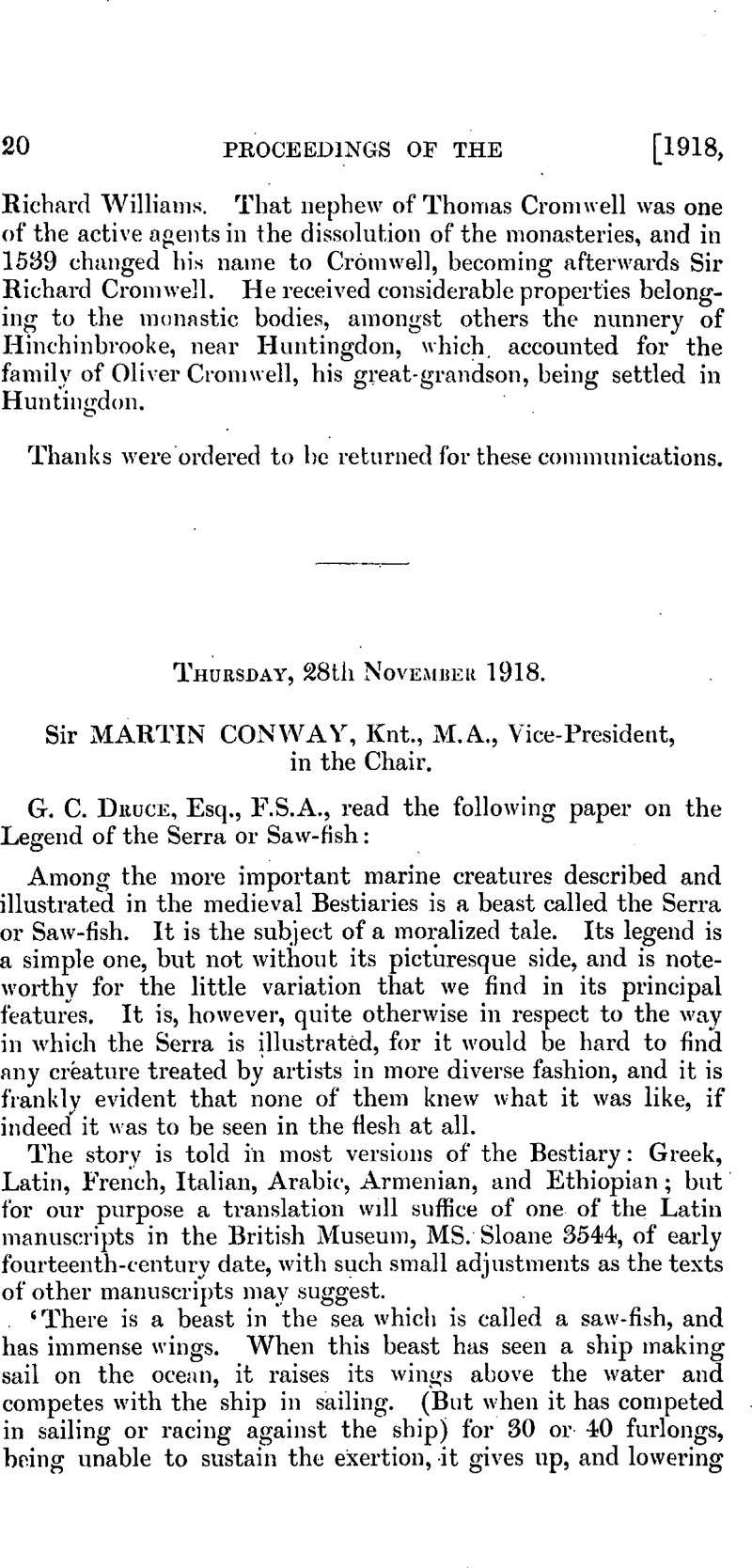No CrossRef data available.
Article contents
Thursday, 28th November 1918
Published online by Cambridge University Press: 10 May 2010
Abstract

- Type
- Proceedings
- Information
- Copyright
- Copyright © The Society of Antiquaries of London 1919
References
page 21 note 1 Cf. Matt. xxiv. 13. Among the Latin Bestiaries which have approximately the same text may he mentioned: MSS. 10074 Bibl. Roy., Brussels and 233 at Berne, of which transcriptions are given in Cahier's Mélanges d'Archéologie, vol. ii, p. 122 ; MSS. Harl. 4751 and 3244 at the Brit. Mus. ; MS. 12 F xiii at Brit. Mus. ; MS. at Sion College: and the version given in the Appendix to the works of Hugo de Saucto Victore, De Bestiis et aliis rebus, bk. ii, ch. 22 (see Migne's Patrologiae Cursus Completus, vol. 177, col. 69).
page 21 note 2 Nos. 233 and 318 in Sinner's Catalogue.
page 22 note 1 Liber xii, cap. 6.
page 22 note 2 See MS. 12 F xiii (B.M.); MS. 22 Westminster Chapter Library; and MS. 254 Fitzwilliam Mus., Cambridge.
page 22 note 3 MS. Nero A v (B.M.) :
When it sees a ship on the high sea it rises up.
To the ship it does great harm, for it goes before the ship Cf. Wright's Popular Treatises on Science, p. 104. MS. 249, Merton Coll., Oxford, reads: ‘Ses eles leve en halt’—and ‘kar devant le veut vait’, which is probably more correct.
page 23 note 1 MS. Vesp. A vii (B.M.) :
The mariners who cross the sea
Are not wishful to meet it;
For it is a great peril of the sea.
It often makes the ship to founder
To which it is able to get near.
See also Hippeau's, M. C. transcription of manuscript at Paris, in Le Bestiaire diviu, Caen, 1852, p. 202Google Scholar.
page 23 note 2 Versions of Pierre and the Bestiaire d'Amour. Text of the former from MS. 3516, Arsenal Library, Paris, in Cahier's Mélanges d'Archéologie, ii, p. 121; of the latter in C. Hippeau's ‘Le Bestiaire d'Amour’, dated 1285, Paris, 1860, p. 39.
page 23 note 3 Anecdota Syriaca, vol. iv, p. 150.
page 23 note 4 Physiologus Syrus, p. 172.
page 23 note 5 Anecdota Syriaca, vol. iv, p. 47.
page 24 note 1 MS. Add. 28260 (B.M.) ; transcribed also by Paul Meyer in Romania, 1872, p. 440 :
When it sees by chance
A ship sailing against the stars (?)
With sails full set,
At once towards the ship it makes its way ;
Its wings are as spread sails,
It reckons itself to be a ship.
page 24 note 2 Ein Tosco-Venezianischer Bestiarius, Halle, 1892, p. 49Google Scholar.
page 24 note 3 Albertus Magnus says that when its wings are lowered it is carried down by its own weight (De animatilbus, lib. xxiv).
page 25 note 1 About the saw-fish, a great fish, having wings or fins after the manner of a saw witli which wood is cut.
page 26 note 1 In the twelfth-century Greek Bestiary at Smyrna the word κιτος is used. For an account, with many plates, of this interesting manuscript see Der Bilderkreis des griechschen Physiologus, by. Strzygowski, J., Leipzig, 1899Google Scholar. In MS. 318 at Berne the saw-fish is called a fish in both heading and text.
page 27 note 1 Illustrated also in Cahier's Mélanges, vol. ii, pl. xix.
page 27 note 2 1 am indebted to Messrs. Bernard Quaritch for the loan of the plate in the catalogue of the Morgan manuscripts.
page 28 note 1 Liber xii, cap. 6.
page 28 note 2 Illustrated also in Cahier's Mélanges, vol. ii, pi. xxiv.
page 28 note 3 Vincent de Beauvais includes the Siren and Sena under one heading, the account of the Siren coming first.
page 29 note 1 MS. Vesp. A vii. In the Arsenal Library MS. the passage in Matt, xxiv. 13 is introduced. In the version of Gervais the symbolism is on the same lines as in Guillaume.
page 30 note 1 2 Cor. xi. 14.
page 30 note 2 MS. Nero A v ; cf. Wright, Popular Treatises on Science, p. 104.
page 31 note 1 Goldstaub, loc. cit.
page 31 note 2 This introduces the next subject. The legend of the turtle-dove declares that if the hen-bird has lost her mate at the hands of the fowler or the hawk, she laments him to the end of her life, and never takes another partner.
page 32 note 1 Hippeau's transcription and MS. Harl. 273 (B.M.) have been used. The latter gives the man's address only.
page 32 note 2 Since the above was written, the property lias been sold, and it has been token away.
page 33 note 1 Gesner has a long dissertation on the subject. Bochart (Hierozoicon, lib. i, ch. 7 and lib. vi, ch. 15) gives a description of the saw-fish from an Arab source, which says that it is as big as a mountain and has saw teeth from head to tail, two cubits long, and like black ebony ; but he regards it as fabulous. In the Italian Bestiaries the saw-fish is named Vergilio, due to the description of certain fish called the Vergiliades, which were found in lakes Como and Maggiore. Pliny tells us that they were to be seen only at the time of the rising of the Vergiliae (Pleiades) and that they were remarkable for the number of their scales, which strongly resembled hob-nails in appearance. This is repeated by Albertus Magnus.
page 34 note 1 I am indebted to Dr. Harmer, F.R.S., for the illustration of the Pristis (fig. 21).




